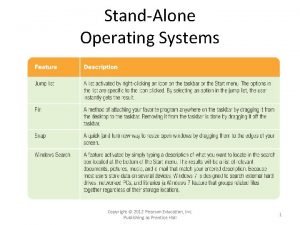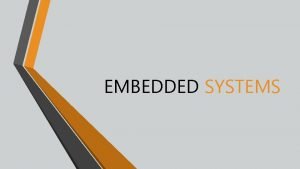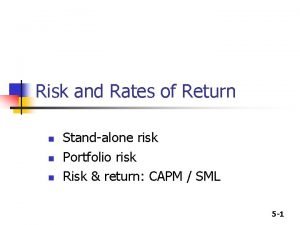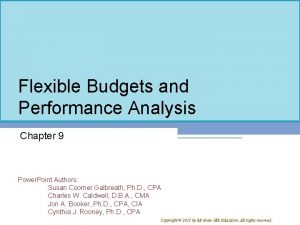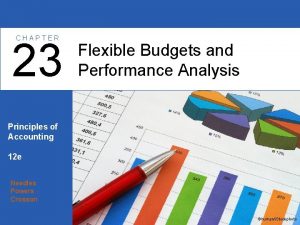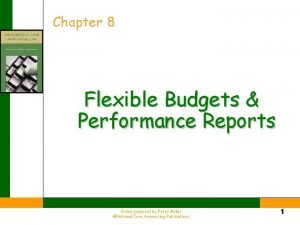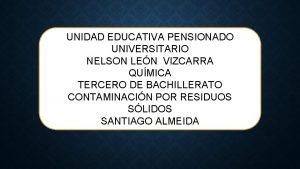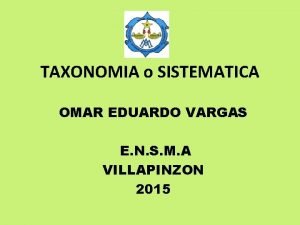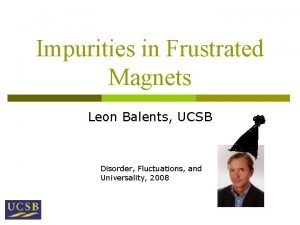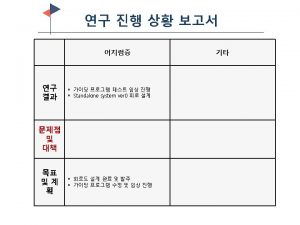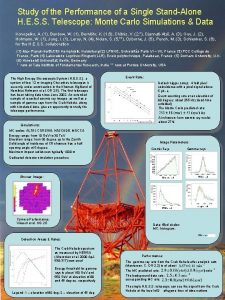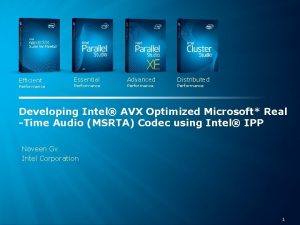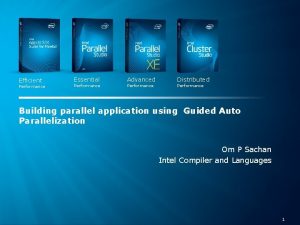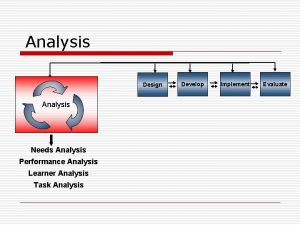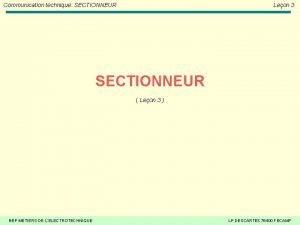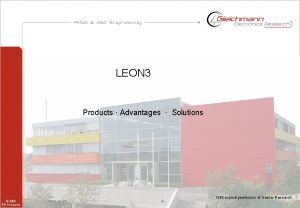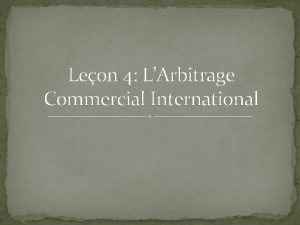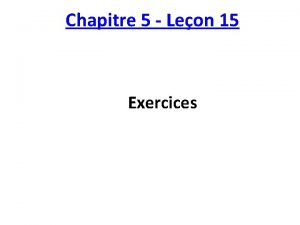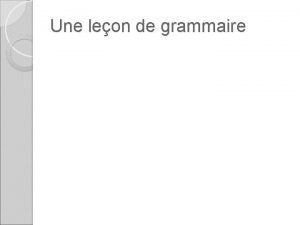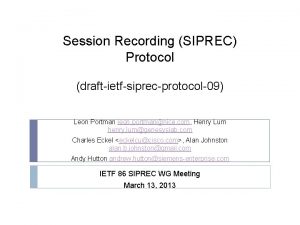Performance Analysis of Standalone and InFPGA LEON 3




























- Slides: 28

Performance Analysis of Standalone and In-FPGA LEON 3 Processors 10 th Workshop on Spacecraft Flight Software Dmitriy Bekker Embedded Applications Group Space Exploration Sector December 7, 2017 This is a non-ITAR presentation, for public release and reproduction from FSW website.

Overview • Choosing a Processor • Benchmarks and Test Targets • LEON 3 Processor Family • RTG 4 Rad. Tolerant FPGA The bulk of the talk • APL CORESAT SBC • Test Configurations (HW) • Performance Results - Benchmarks, Tests, Applications, Resource Utilization, Power • Design Considerations - Cache, Clocking, Instructions, Multicore • Processing Capability – The Big Picture • Conclusions Performance Analysis of Standalone and In-FPGA LEON 3 Processors 04 November 2020 2

Choosing a Processor When considering a new processor for a mission, one of the questions that comes up is: “How does this processor compare with what we have used in the past? ” • Does the manufacturer provide benchmark data? Is per-MHz performance presented? • Does the data have key parameters (compiler, build options, memory type, etc. )? • Is power consumption considered? • What is the achievable max frequency of the compared processors? • If it’s a soft-core FPGA implementation: - Is resource utilization tracked? - What IP is instantiated? - Are timing / max frequency limitations of the FPGA technology known? Performance Analysis of Standalone and In-FPGA LEON 3 Processors 04 November 2020 3

Choosing a Processor • Consider this: Many C&DH systems have an FPGA • “Modern” space-ready FPGAs are fairly large: - Have many logic resources, and also carry embedded RAM blocks, DSP slices, etc. - Often have room to host one or more embedded soft processors • Some advantages of hosting a soft-processor inside an FPGA: - Possibly can get rid of hard processor (lower total SWa. P) - Easier integration with IP internal to the FPGA - Flexibility in processor configuration • But… - Max frequency is typically much lower - IP may not have gone through as much testing as hard processor This presentation compares performance of soft and hard processors of the LEON 3 family using carefully tracked benchmarks, applications, and architectural design options. Performance Analysis of Standalone and In-FPGA LEON 3 Processors 04 November 2020 4

Benchmarks and Test Targets • Synthetic benchmarks – industry standard - Dhrystone (integer performance, popular, has some flaws) - Core. Mark (integer performance) - Whetstone (floating-point performance) • Testing applications – our own small subsystem testers - Memcpy-bench (time the performance of memcpy) - Nandfctrl-test (time the performance of NAND Flash interface) • End-to-end application – a real-world example - Terrain Relative Navigation LEON 3 Test Targets Hard u. P UT 699 Hard u. P UT 700 Soft u. P RTG 4 SRAM SDRAM DDR 3 SRAM Dev. Boards Performance Analysis of Standalone and In-FPGA LEON 3 Processors APL SBC 04 November 2020 5

LEON 3 Processor Family • 32 -bit processor, SPARC V 8 instruction set • AMBA 2. 0 AHB bus interface • On-chip debug support • RTEMS, Linux, Vx. Works support • Single-core hard processors evaluated (fault tolerant): - UT 699 (66 MHz): FPU, 8 KB D-cache, 8 KB I-cache, 4 x Sp. W, etc. - UT 700 (166 MHz): FPU, 16 KB D-cache, 16 KB I-cache, 4 x Sp. W, etc. • Single-core soft processor (configurable fault tolerance): - Fully customizable: FPU, cache size, mem ctrl, IP selection, etc. - Can build multi-CPU systems (subject of FY 18 R&D effort) - Max frequency depends on FPGA target technology and complexity of entire design Performance Analysis of Standalone and In-FPGA LEON 3 Processors 04 November 2020 6

RTG 4 Rad. Tolerant FPGA Relatively large, reprogrammable flash FPGA, with embedded RAM blocks, DSP slices, Sp. W interfaces, u. PROMs, SERDES, etc. Performance Analysis of Standalone and In-FPGA LEON 3 Processors 04 November 2020 7

APL CORESAT SBC Specifications • • Volume: Mass: Pwr I/F: Pwr: Memory: SSR: Data I/F: 400 cm 3 (15. 2 x 9. 7 x 1. 8 cm; 0. 33 U) 0. 22 kg (excludes chassis) 3. 3 V, 1. 2 V, remote V sense, F sync 0. 6 W (Stand-By) / 4. 0 W (typ, est. ) Two 16 MB SRAM, 8 MB MRAM 16 GB 4 -port Sp. W router, 8 discrete I/O, SERDES in/out, 2 analog or IF inputs and outputs, JTAG • Missions: DART (1 st user), others planned B. Bubnash Performance Analysis of Standalone and In-FPGA LEON 3 Processors 04 November 2020 8

Test Configurations (HW) • UT 699 Dev. Board (66 MHz): - SRAM Waitstates: RD=1, WR=1 - SDRAM Parameters (in cycles): TRP=2, TRFC=5, CAS=2 • UT 700 Dev. Board (100 MHz) - SDRAM Parameters (in cycles): TRP=3, TRFC=8, CAS=3 • CORESAT SBC UT 700 (100 MHz) - SRAM Waitstates: RD=1, WR=0 • CORESAT SBC Soft LEON 3 (50 MHz) - SRAM Waitstates: RD=0, WR=0 • Benchmark chart figures reported as per-MHz - Full-capability performance values also presented • All soft LEON 3 builds were for non-FT, commercial version Performance Analysis of Standalone and In-FPGA LEON 3 Processors 04 November 2020 9

Performance Results Benchmarks, Tests, Applications, Resource Utilization, Power Performance Analysis of Standalone and In-FPGA LEON 3 Processors 04 November 2020 10

Benchmark: Dhrystone • • Compiler: BCC v 4. 4. 2, release 1. 0. 45 Options: -O 3 -mcpu=v 8 -msoft-float Performance Analysis of Standalone and In-FPGA LEON 3 Processors 04 November 2020 11

Benchmark: Core. Mark • • Compiler: BCC v 4. 4. 2, release 1. 0. 45 Options: -O 3 -mcpu=v 8 -msoft-float -funroll-loops -fgcse-sm Performance Analysis of Standalone and In-FPGA LEON 3 Processors 04 November 2020 12

Benchmark: Whetstone • • Compiler: BCC v 4. 4. 2, release 1. 0. 45 Options: -O 2 -DDP -mcpu=v 8 (add -mtune=ut 699 for UT 699, add -msoft-float for No-FPU test) Performance Analysis of Standalone and In-FPGA LEON 3 Processors 04 November 2020 13

Test: Memcpy • • Compiler: BCC v 4. 4. 2, release 1. 0. 45 • Options: -O 2 -mcpu=v 8 -msoft-float SPARC optimized “newcpy”: https: //github. com/torvalds/linux/blob/master/arch/sparc/lib/memcpy. S Performance Analysis of Standalone and In-FPGA LEON 3 Processors 04 November 2020 14

Test: Flash Memory Performance • NAND Flash offers some benefits over NOR Flash: - Higher density, faster program time - Generally better radiation performance • But… - NOR is easier to interface with (on LEON 3, can use memory bus) - NAND requires a communication protocol (commands + data) • NAND flash requires a controller IP core, and therefore can only be attached to a soft-core processor implementation / FPGA logic ONFI 2. 0 Timing Mode Read Page (us) Erase Block (us) Program Page (us) 0 491 570 1 267 570 • • • Program Cached 2 -Pages (us) Lead-Out (us) Est. Throughput 730 1061 187 65. 1 Mbps 557 714 187 96. 8 Mbps Target build: Soft LEON 3 / RTG 4 / 50 MHz / CORESAT SBC Compiler: RCC v 4. 10, release 1. 2. 19 Options: -O 2 -mcpu=v 8 -msoft-float Performance Analysis of Standalone and In-FPGA LEON 3 Processors (assuming back-to-back program cache performance sustained) 04 November 2020 15

Application: Terrain Relative Navigation • • Compiler: RCC v 4. 10, release 1. 2. 19 Options: -O 2 -mcpu=v 8 (add -mtune=ut 699 for UT 699) Performance Analysis of Standalone and In-FPGA LEON 3 Processors 04 November 2020 16

Application: Terrain Relative Navigation • • Compiler: RCC v 4. 10, release 1. 2. 19 Options: -O 2 -mcpu=v 8 (add -mtune=ut 699 for UT 699) Performance Analysis of Standalone and In-FPGA LEON 3 Processors 04 November 2020 17

Resource Utilization: RTG 4 Dev. Kit Performance Analysis of Standalone and In-FPGA LEON 3 Processors 04 November 2020 18

Resource Utilization: CORESAT SBC Performance Analysis of Standalone and In-FPGA LEON 3 Processors 04 November 2020 19

Power Consumption: CORESAT SBC Performance Analysis of Standalone and In-FPGA LEON 3 Processors 04 November 2020 20

Design Considerations Cache, Clocking, Instructions, Multicore Performance Analysis of Standalone and In-FPGA LEON 3 Processors 04 November 2020 21

Cache Design Considerations Actual resource utilization data for RTG 4 builds Miss rate is theoretical, from reference below Note the LSRAM resource cost for different associativity From: "Computer Architecture: A Quantitative Approach" by John Hennessy & David Patterson (5 th Edition) Performance Analysis of Standalone and In-FPGA LEON 3 Processors 04 November 2020 22

Clocking and Instructions Storage • A couple beneficial soft-core LEON 3 design options were studied as part of this work • CLK 2 X design: - Run CPU at 2 x AHB bus frequency - CPU will achieve higher performance when executing out of cache - Save power vs. running both CPU and AHB at the same higher clock frequency - Unfortunately, this only makes sense for target FPGA technology that can meet timing at higher CPU frequencies (not for RTG 4) • For memory constrained systems, consider REX extension: - More compact code: 16 -bit instructions (vs. standard 32 -bit) ~7% size reduction vs. GCC compiled code (greater for LLVM) § Instruction cache miss rate reduction § - New BCC 2 compiler handles encoding - Soft-core processor must have REX decoding engine enabled REX Presentation: https: //indico. esa. int/indico/event/146/contribution/3/material/1/0. pdf Performance Analysis of Standalone and In-FPGA LEON 3 Processors 04 November 2020 23

Multicore / Parallel Programming • In FY 18, we’re looking into SMP RTEMS with Open. MP support - Profile code execution - Insert parallelization pragmas in key code segments to farm out execution out to multiple CPU cores • Goal: reduce total application execution time Performance Analysis of Standalone and In-FPGA LEON 3 Processors 04 November 2020 24

Processing Capability The Big Picture Performance Analysis of Standalone and In-FPGA LEON 3 Processors 04 November 2020 25

What is the Technology Tradespace? Effort Perform. Gen. Purpose Design Power Req. Rad. Hard Singlecore Low High Low Yes Medium High Medium Yes FPGA High Low Medium Yes GPU Medium High No Neuromorphic High Medium Very Low No Multicore coexist Target The future in space? Highest performance option on current Rad. Hard technology CORESAT SBC Our FY 18 multicore work Multiple FY 18 efforts in this area

Conclusions • A soft-core LEON 3 processor can be configured to meet or exceed the per-MHz performance of a hard LEON 3 processor - Max frequency of a hard LEON 3 processor is higher than what is achievable with RTG 4 FPGA technology for a soft processor - A single hard LEON 3 processor will outperform a single soft processor • Most missions have a dense FPGA as part of DSP / logic functions - If there is room, adding a soft-core processor (or two…) may augment the total processing capability or even make an additional hard processor unnecessary - Integration/test of IP cores can be simpler with the flexibility offered by having a soft processor on the same chip • SPARC optimized memcpy is better performing than standard memcpy (especially for unaligned memory accesses) • For soft-core designs, consider FPU performance, resource utilization, cache config. , and power impact (don’t overdesign!) • Current efforts are looking at multi-core systems / parallel programming targeted at soft-core processor designs Performance Analysis of Standalone and In-FPGA LEON 3 Processors 04 November 2020 27

 What is standalone operating system
What is standalone operating system Docker spark cluster
Docker spark cluster Embedded systems are not always standalone devices
Embedded systems are not always standalone devices Standalone blast
Standalone blast Stand alone risk example
Stand alone risk example Acn internet plans
Acn internet plans Bars performance appraisal
Bars performance appraisal Behaviorally anchored rating scale
Behaviorally anchored rating scale Jcids process
Jcids process Chapter 9 flexible budget and performance analysis
Chapter 9 flexible budget and performance analysis Flexible budgets and performance analysis
Flexible budgets and performance analysis Flexible budget performance report example
Flexible budget performance report example Puniversitario campus virtual
Puniversitario campus virtual Preposition with average
Preposition with average Filo del león
Filo del león Que significa sed sobrios, y velad
Que significa sed sobrios, y velad Concept of management-raymond g. leon
Concept of management-raymond g. leon Nuevo león
Nuevo león Fabula el leon y el raton para imprimir
Fabula el leon y el raton para imprimir Leon leads teacher evaluation score
Leon leads teacher evaluation score Esperimento 20 dollari per una menzogna
Esperimento 20 dollari per una menzogna Leon burnett
Leon burnett Accent names
Accent names Juan ponce de leon nationality
Juan ponce de leon nationality Juan ponce de leon impact
Juan ponce de leon impact Ponce de leon accomplishments
Ponce de leon accomplishments Juan ponce de leon obstacles
Juan ponce de leon obstacles Leon balents ucsb
Leon balents ucsb Troy leon gregg
Troy leon gregg
